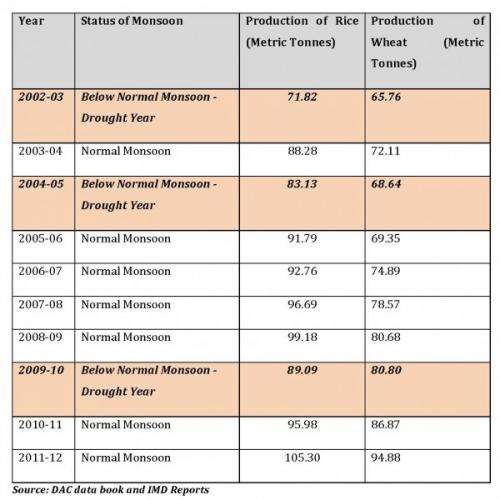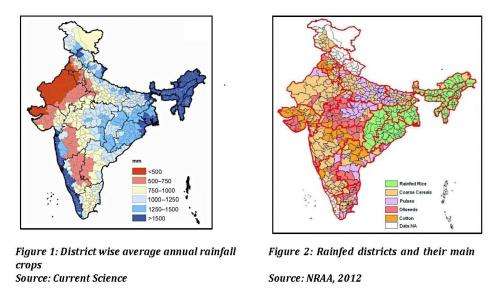Reducing the dependency on Indian monsoon precipitation

India, a primarily agrarian country, is dependent on rain for 60 percent of its net sown agricultural area. The southwest monsoon (June-September) provides about 80 percent of the area's precipitation. As can be expected, a good monsoon season with sufficient rainfall results in enhanced agricultural production, whereas a bad monsoon season with low precipitation negatively impacts the economy through lower production.
The table below shows the impact of a normal versus below normal southwest monsoon season on the production of two major food grains – rice and wheat – across the past decade.
The data shows a decrease in the production of rice and wheat during drought years (2002, 2004 and 2009).
Precipitation in India is unevenly distributed over time and space. As shown in Figure 1, average annual rainfall varies across districts, with less than 500mm in districts of western Rajasthan to more than 1,500mm in the northeast. Figure 2 shows that rain-fed rice is mostly prevalent in the eastern and northeastern parts of India, whereas coarse cereals are mainly confined to western and central regions.
The India Meteorological Department has predicted below average rainfall, 95 percent of the average 100-year rainfall data, during the upcoming monsoon season. Monsoon rain in the range of 96-100 percent of the long-period average is considered normal. Meteorologists from the World Meteorological Organisation and Skymet have also predicted a weak monsoon over most parts of the country this year.

The present scenario exemplifies the importance of making agriculture in India more drought resistant and increasing agricultural water use efficiency to produce "more crop per drop." The Centers for International Projects Trust, affiliated with the Columbia Water Center at the Earth Institute, has undertaken various low cost technological innovations to reduce the amount of water used for the production of rice and wheat.
In Central Punjab, India, the center and Punjab Agricultural University worked with 8,000 farmers to achieve a 12-15 percent reduction in water use through the use of low cost tensiometers, a tool used to measure the moisture content of the soil. These savings also correspond to a reduction in energy usage for groundwater extraction. The center plans to introduce a new, easy-to-use and low-cost soil moisture sensor that will inform farmers when to irrigate their fields.
In Gujarat, India, the center has been pilot testing the use of GW-11 variety of wheat with farmers in the Mehsana district of North Gujarat. GW-11 is drought resistant and produces yields that are comparable to the traditional variety of wheat. The center is in the process of collecting this harvest season's GW-11 crop yield measurement data with the intent to analyze the production versus the number of irrigations. Initial findings indicate that the GW-11 variety requires less irrigation than traditional wheat.
Low cost innovations not only reduce water usage in agriculture but also make farmers less vulnerable to climate variability, especially as it relates to the monsoon season. Simple solutions like the ones being developed by the center have the potential to be widely adopted and lead to significant water savings and growth in agricultural production.
Provided by Columbia University





















